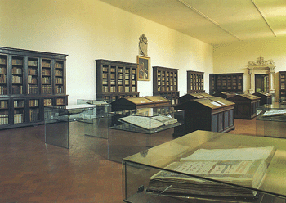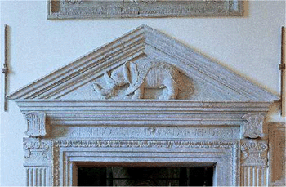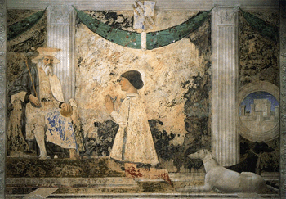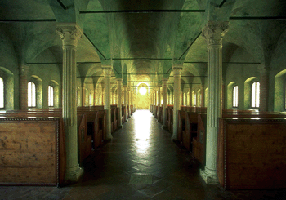| There are those who maintain
that to be the protagonists of wicked deeds in a crime chronical provides
greater notoriety than, for example, being a benefactor, a Nobel prize
recipient in chemistry, or the author of a valuable fresco cycle from the
13th century. Gianciotto Malatesta seems to confirm this thesis. It is
true that in an era where there were no mass media, to be sung about by
Dante in the Divine Comedy could contribute to a wide repute. But it is a
fact that from the long and important history of this family of Romagna,
which dates back to a Malatesta cited in a judicial document in 1186, the
most famous remains the uxoricide and fratricide Gianciotto who, in 1283,
"put away" his wife Francesca (daughter of Guido Minore from Polenta,
married in 1275) and his own brother Paolo, king of adultery. The tragedy,
it is said, occurred in the XII century castle of Gradara, powerful
squared-shape fortress with high cornerstone towers, quadrangular donjons,
crenellated battlements. The Malatesta dynasty, established in Rimini in
the XIII century with an allegiance to the Guelph party, not only reached
with its members remarkable power, but exercised it for decades over most
of Romagna and was protagonist of the local history for many generations,
even leaving testimonies of high cultural and architectural value.
Malatesta strongholds are found in Cesena, in Montefiore Conca, in
Verrucchio, but we want here to recall in particular two exceptional
monuments: Cesena's Malatesta Library and Rimini's Malatesta Temple. The
Library, founded in 1447 by Domenico Novello, Lord of Cervia and Cesena,
where he died in 1465 leaving the city to the Papal State, is a wonderful
example of Renaissance architecture, inspired by the Library of S. Marco
di Michelozzo: in the shape of a basilica with three naves, 340
manuscripts and 48 printed volumes are preserved there. The Malatesta
Temple or of St. Francis at Rimini was commissionned to Leon Battista
|
Alberti by Sigismondo Pandolfo
(1417-1468), Lord of Rimini, natural son of Pandolfo III: Sigismondo was a
very skilful and sought-after condottiere who, in 1435, commanded the
papal army and then served Venice and for the Republic even fought the
Turks in Peloponnese. But his figure is at the same time remembered as one
of a generous benefactor who always was around scholars and artists. For
the Rimini Temple, Sigismondo imported stones directly from Istria,
purchased in Fano part of the stones intended for the construction of a
bridge on the Metauro, plundered left marble from the ancient Roman port.
Because of an ancient and popular custom in Romagna, a surname was given
to numerous members of the Malatesta dynasty: so, Malatesta III
(1299-1364) was called Guastafamiglia (the Ruiner of the Family), and
Malatestino, who died in Rimini in 1317, was called dall'Occhio (because
he was blind in one eye); and Dante, who in his Commedia, cites, other
than Gianciotto, at least two other family members, Malatesta II, who died
in Rimini in 1312, as the Old Mastiff of Verrucchio (Inferno, XXVII) and
the above mentionned Malatestino as the Young Mastiff.
When we cite
Pascoli who wrote ôSunny Romagna, sweet country which was ruled by Guidi
and Malatesta..." we know who it relates to: to a family whose domination,
in fact, began in the early '300, from Malatesta II of Verrucchio over
Rimini and other land in Romagna and in the Mark of Ancona; a dynasty
that, with its members, was the protagonist of considerable historical
adventures; who had official recognition of the seigniory, exercised for
already more than a century when, in 1392, the Malatesta dynasty received
from the papacy the formal investiture of their land; and was extinguished
in 1503, when Pandolfo V (who died in 1534) was defeated by Cesare Borgia
and compelled to give up Rimini to Venice. |




|



